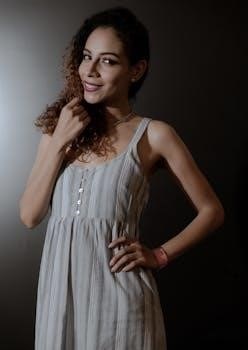Overview of “The Woman in Black”
Susan Hill’s “The Woman in Black” is a chilling ghost story centered around Arthur Kipps’s haunting experience at Eel Marsh House. This classic tale, available in PDF format, explores themes of isolation and fear, delivering a menacing spectre in a small English town. It begins on Christmas Eve.

Synopsis of the Story
The story of “The Woman in Black” unfolds as Arthur Kipps, a young solicitor, is tasked with settling the affairs of the recently deceased Mrs. Alice Drablow. He journeys to the remote Eel Marsh House, located in the desolate reaches of the English countryside. The house is only accessible via a causeway that is submerged during high tide, immediately setting a tone of isolation and foreboding. As Kipps delves into Mrs. Drablow’s documents, he begins to experience unsettling events and glimpses of a mysterious woman dressed entirely in black.
These sightings are accompanied by an increasing sense of dread and unease. The local villagers are reluctant to speak about the woman, hinting at a tragic past and a vengeful spirit. Kipps soon discovers the horrifying truth⁚ the woman in black is the ghost of Jennet Humfrye, Mrs; Drablow’s sister, who seeks retribution for the loss of her child. Her appearances foreshadow the deaths of children, making her a harbinger of tragedy. As Kipps becomes more deeply entangled in the mystery, he realizes the danger he and those around him are in.
Arthur Kipps’s Experience at Eel Marsh House
Arthur Kipps’s time at Eel Marsh House is characterized by growing dread and isolation. Initially, he approaches his task with professional detachment, intending only to sort through the papers of the late Mrs. Drablow. However, the atmosphere of the house, combined with the bleak and desolate landscape, begins to unsettle him; The house is shrouded in mist and cut off from the mainland during high tide, amplifying his sense of being alone and vulnerable.
As he delves deeper into his work, Kipps experiences a series of disturbing events. He hears unexplained noises, sees fleeting movements, and feels an increasing sense of unease. The sightings of the woman in black become more frequent and terrifying, each appearance accompanied by a palpable sense of malice. Kipps’s rational mind struggles to reconcile these supernatural encounters with his logical understanding of the world. His fear escalates as he uncovers the tragic history of the house and the vengeful spirit that haunts it, leaving him forever changed.

The Appearance and Significance of the Woman in Black
The Woman in Black is depicted as a gaunt, wasted figure, always dressed in old-fashioned black clothing. Her face is described as white and thin, conveying an image of illness and decay. She often appears at a distance, her presence marked by a profound sense of unease and dread. Her spectral appearance is not merely frightening; it is deeply unsettling, suggesting a profound sorrow and a relentless desire for revenge.
The significance of the Woman in Black lies in her role as a harbinger of death and tragedy. Her appearances are invariably linked to the deaths of children, revealing her as a vengeful spirit seeking retribution for the loss of her own child. She embodies the destructive power of grief and the enduring impact of past traumas. As a symbol, she represents the dark side of motherhood, twisted by sorrow and driven by an insatiable need for revenge. Her presence casts a shadow over the entire narrative, underscoring the themes of loss, guilt, and the haunting power of the past.
Themes of Isolation and Fear
Isolation and fear are central themes in “The Woman in Black,” permeating the narrative and shaping Arthur Kipps’s experience at Eel Marsh House. The remote setting of the house, accessible only by a causeway that disappears at high tide, immediately establishes a sense of physical isolation. This isolation is compounded by the reluctance of the local villagers to speak of the Woman in Black or the tragic events associated with her, creating a sense of social isolation for Kipps.
The oppressive atmosphere of Eel Marsh House amplifies the theme of fear. Kipps is haunted by unexplained noises, eerie occurrences, and the pervasive feeling of being watched. The dense fog that often surrounds the house further intensifies the sense of unease, blurring the line between reality and the supernatural. The fear experienced by Kipps is not merely a response to the ghostly presence of the Woman in Black; it is a deeper, more primal fear rooted in the unknown and the inescapable grip of the past. These themes create a chilling and suspenseful reading experience.

Adaptations⁚ Film and Stage
“The Woman in Black” has seen successful adaptations to both film and stage. The story’s inherent spookiness translates well to visual and theatrical mediums, offering different interpretations. These adaptations have made the chilling tale accessible to wider audiences, amplifying its cultural impact.
Film Adaptations
Several film adaptations of Susan Hill’s “The Woman in Black” have brought the chilling narrative to the big screen. One notable adaptation features Arthur Kipps encountering a wasted young woman in black at a funeral, sparking a creeping unease. The locals’ reluctance to speak of her deepens the mystery. This cinematic version explores the terrible purpose behind the spectral figure.
Analysis of “The Woman in Black” film reveals how it translates the novel’s themes into a visual medium. The film typically emphasizes the gothic atmosphere and employs jump scares to heighten tension. It showcases the isolation of Eel Marsh House and Arthur Kipps’s growing fear as he uncovers the tragic history. These adaptations often make alterations to the plot or character portrayals, offering unique interpretations while preserving the core essence of the ghost story.
Through visual storytelling, the film adaptations provide audiences with a visceral experience of the haunting, further solidifying “The Woman in Black” as a cornerstone of modern horror. The film’s success has contributed to the story’s continued popularity, inspiring new generations to engage with this terrifying tale.
Stage Adaptations
The stage adaptation of “The Woman in Black” presents a unique theatrical experience, distinguished from its film counterparts. It often emphasizes minimalist sets and atmospheric lighting to create a palpable sense of dread. The play relies heavily on sound effects and inventive staging to evoke the supernatural. This version, in particular, highlights the narrative’s psychological aspects, delving into Arthur Kipps’s unraveling sanity.
Actors bring the haunting tale to life through intense performances, capturing the fear and isolation that permeate Susan Hill’s novel. The stage version benefits from direct audience engagement, creating a shared sense of unease as the story unfolds. The adaptation often uses a play-within-a-play structure, where an older Arthur Kipps recounts his experiences to a younger actor, adding layers to the storytelling.
The lack of elaborate special effects on stage requires the audience to use their imagination, making the experience all the more unsettling. This interactive element has contributed to the play’s long-running success, becoming a staple of British theatre and demonstrating the enduring appeal of “The Woman in Black.” The adaptation’s popularity shows it’s ability to thrill audiences with its atmosphere.
Susan Hill’s Writing Style
Susan Hill’s writing style in “The Woman in Black” is characterized by its atmospheric and evocative prose, creating a palpable sense of dread and suspense. She employs detailed descriptions of the setting, particularly Eel Marsh House and its surroundings, to establish a chilling and isolated atmosphere. Her use of language is precise and deliberate, building tension gradually throughout the narrative.
Hill masterfully utilizes foreshadowing, hinting at the impending horror and creating a sense of unease in the reader. She excels at creating believable characters, grounding the supernatural elements in a realistic context. Her narrative voice is often introspective, allowing readers to connect with Arthur Kipps’s growing fear and vulnerability. The effectiveness of Hill’s style lies in her ability to tap into primal fears.
The sense of isolation is heightened through Hill’s descriptions, emphasizing Kipps’s separation from the outside world. She creates a claustrophobic environment, trapping both the protagonist and the reader in the unfolding horror. Hill’s economical prose and skill at pacing contribute to the story’s relentless sense of dread. Her style ensures that the reader is left with a lasting sense of unease.

Availability of “The Woman in Black” in PDF Format
“The Woman in Black” is widely available in PDF format across various online platforms, making it easily accessible for readers seeking to experience Susan Hill’s chilling ghost story. Project Gutenberg offers a free, digitized version of the book, ensuring that it can be enjoyed at no cost. Numerous websites provide PDF downloads of the novel, catering to different preferences and devices.
Some platforms offer the PDF as part of a collection of classic literature, while others focus specifically on horror and gothic tales. Online libraries and digital bookstores often include “The Woman in Black” in their PDF offerings, alongside other works by Susan Hill and similar authors. Readers can also find the PDF through file-sharing sites and online archives, although it’s important to ensure the legality and safety of these sources.
The availability of “The Woman in Black” in PDF format allows readers to access the story on various devices, including e-readers, tablets, and computers. This makes it a convenient option for those who prefer digital reading. The story can also be acquired in EPUB format.
Comments